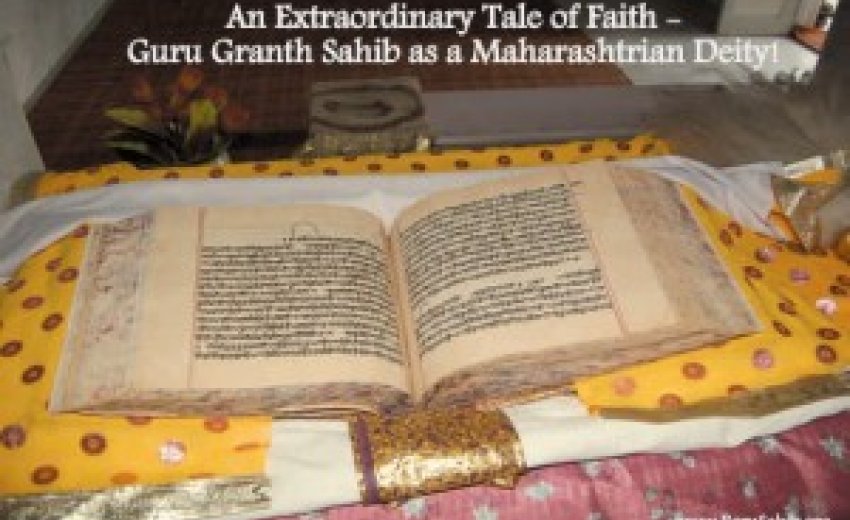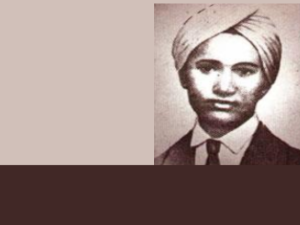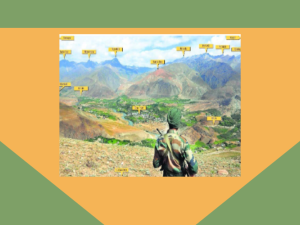– Guru Granth Sahib as a Maharashtrian Deity!
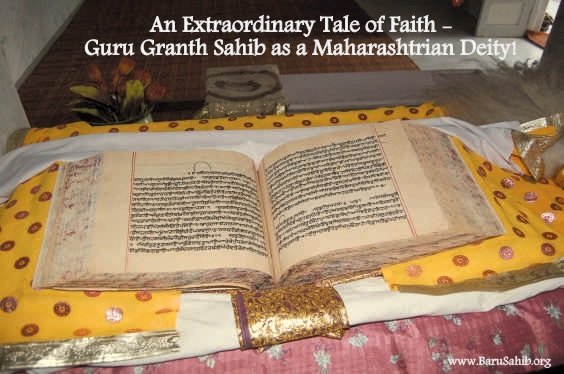
08 Dec: Domegaon is a village in the outlying Shrirampur Tehsil of Ahmednagar District in Maharashtra located on the banks of River Godavari, 80 Kms from Ahmednagar, 22 Kms from Shrirampur and 7 Kms from hokar on the Shrirampur- Aurangabad road. It is equidistant from Nashik, Aurangabad and Manmad – some 100 Kms, or 2-1/2 hours journey by bus. Belapur Railway Station is the nearest railway link, about one kilometer from Shrirampur Bus Stand, while Pune Lohegaon Airport, about 110 km from Ahmednagar, is the nearest air link.
I would not have dreamt of going to this obscure village even before 21 June 1994, but for my colleague, Capt. Hardev Singh’s insistence. He appeared excited. We did not have much information about the place except a hearsay report: “The villagers of Domegaon and neighborhood have total faith in Guru Granth Sahib. Whenever river Godavari got flooded they took out the holy Granth and touch the water, which then receded without causing any damage to the village. This has been the practice for the last 165 years, ever since an old saint meditated with this volume of the holy Granth.”
On checking at Ahmednagar bus stand, we came to know that it takes two hours by bus to Shrirampur from where a local bus goes to Domegaon. Going along the road marked by Neem and Keekar trees, through lush vegetation and ripening sugarcane fields, we reached Shrirampur at 11 A.M.
With a view to gathering more details of the place and the route, we approached the first available residents. They took us on two scooters to Veena Saree Centre, owned by Khem Singh Batra, President, Gurdwara Prabandhak Committee, Domegaon. We were told that the keys of the Gurdwara at Domegaon were with the Sewadar (caretaker) Gurcharan Singh Saluja, who had gone for collection of stores and was due to return shortly.
As we waited for the Sewadar, we were briefed by Prithipal Singh regarding the place: “More than 165 years ago, an old hand-written copy of Guru Granth Sahib came to be preserved in Domegaon. Sikhs in Shrirampur came to know of it only about 50 years ago through a Bijnori Sikh, Bedekar, who used to frequent these villages for business. The construction of the Gurdwara was initiated by one Mr. Ahuja, a factory manager at Ganeshpur Sugar Mills, with the efforts of the Sikh Sangat of the surrounding areas under the supervision of Baba Harnam Singh of Gurdwara Langar Sahib, Nanded.
“The Sewadar stays at Shrirampur because there is no Sikh family in Domegaon but he goes to Domegaon daily and the keys of the Gurdwara remain with him. He collects the construction material and the materials for performing rituals at the Gurdwara.
We were told that the Akhand Paath (continuous recitation of Guru Granth Sahib) is performed every year on Guru Nanak’s birthday i.e., on Kartik Poornima. The Sangat of Shrirampur visits Domegaon on every Pooranmashi (full moon night).
“The villagers of the area take out a procession around the village with the holy man of the village carrying Guru Granth Sahib on his head on occasions like Holi and Diwali. They celebrate all festivals in the compound of the Gurdwara after prayers to Guru Granth Sahib, for which they have a deep devotion. A special congregation is also arranged in the first week of January every year. We tried to bring the holy volume to Shrirampur as we felt that there was no Sewadar. But the villagers refused to part with it stating that it was their Dev (Chief Deity), which could not be taken away from Domegaon. If their Dev is taken away, they will surely be destroyed by floods. Such was the unflinching faith of the locals in the Holy Guru Granth Sahib”
Meanwhile, the Sewadar arrived. We hired an auto-rickshaw to proceed to Domegaon. En route, we halted at Shrirampur Gurdwara, a magnificent construction. There we met Trilok Singh Sethi, a respected and prosperous businessman of the area and Special (honorary) Executive Magistrate. He offered to send his car to Domegaon, which we could not refuse as he wanted the car to be blessed by Baba Birdh Sahib of Domegaon. The Sikh saint, who originally brought the holy Guru Granth Sahib and meditated on the banks of river Godavari at Domegaon, is known as Birdh Baba Sahib, meaning the ‘respectable old man’.
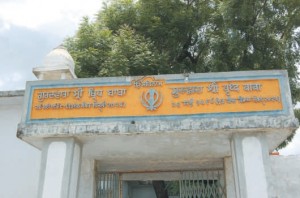 Our 15 km journey along Nashik-Shrirampur-Aurangabad road was comfortable. At village Bhokar, we found the road turning to Birdh Baba Domegaon (Kamalpur). At Domegaon, we stopped alongside river Godavari, close to the bridge in front of the imposing building of Gurdwara Birdh Baba. Just adjoining to it stands a Krishna temple, a mosque, a Buddhist Gompa and a Hanuman temple. Domegaon is a beautiful village with pictureseque landscape and the surroundings surcharged with spiritual vibrations.
Our 15 km journey along Nashik-Shrirampur-Aurangabad road was comfortable. At village Bhokar, we found the road turning to Birdh Baba Domegaon (Kamalpur). At Domegaon, we stopped alongside river Godavari, close to the bridge in front of the imposing building of Gurdwara Birdh Baba. Just adjoining to it stands a Krishna temple, a mosque, a Buddhist Gompa and a Hanuman temple. Domegaon is a beautiful village with pictureseque landscape and the surroundings surcharged with spiritual vibrations.
A marble stone on the Gurdwara wall had the following inscription:
“The construction of Gurdwara Sri Birdh Baba, Domegaon was started at the hands of a Nanded saint on 25 May 1968. About 150 years ago, a Sikh saint of Punjab, who had a hand-written copied version of Guru Granth Sahib established it in this place in a thatched hut, which has now been converted into a Gurdwara. The village is situated on the banks of Godavari, which often got flooded since the times of the Birdh Baba. Guru Granth Sahib was worshipped and taken on the head to Godavari and prayers were offered to Ganga Mai (Godavari) for receding of floods. The local people have full faith in Guru Granth Sahib and Birdh Baba and they have seen with their eyes that with the prayer, flood recedes and the village is saved from losses. This tradition continues till date. This year, when the floods came on 6 August, 1968, the village people repeated the same thing and there was no damage to the village from flood waters.”
We washed our faces, hands and feet and the Sewadar brought the old volume (Beerh) of Guru Granth Sahib from its resting place to the main hall. After prayers, we were allowed to study it. Its size is more than double than that of the normal printed Beerh. It contains 1006 pages. It was apparent that it was written long back. It starts with a list of contents preceded with the dates of its writing as Mash Sudi 5, Samvat 1901 (1844 A.D.). The list of contents has three parts. The first list contains the names of all the verses (Baanis). The second is the list of all ragas. The third is the list of the first line of all the Shabads (hymns) in the Beerh. A few pages are also given for the contents. The Baanis included are:
Nisan Guruji Jap(u) (p.1), Sodar – five Shabads (p.6), So Purkh – four Shabads (p.7), Sohila/Aarti – five Shabads (p.8), Raag Majh (p.64), Gauri (p.105), Aasa (p.239), Gujri, Devgandhari and other Ragas; Sloka Sahaskriti, Gatha, Funhe, Choubole, Sloka Kabir Ji ke, Sloka Farid Ji ke, Swaeeye Kalaur, Bhatton-ke-sloka, Waran-te-Wadheek Sloka, tatha-Gost-Mlaar Naal Hoi, Ratan-mala, Hakikat Raje-Sivnabh-ki, Raagmala, besides method of preparing ink and Chalittar-Jyoti-Jyot Samawne ke, being the record of merging with the Divine Light of the first nine Gurus, but it has no record of Guru Gobind Singh in the list. It may be that this Beerh was started during the time of Guru Gobind Singh. Writing is in black ink. Pages 1 to 20 are much older than the remaining pages. The sequence of Raag/Shabad/Sloka after Slokas of Guru Teg Bahadar is not as per Kartarpuri Beerh or Beerh Bhai Banno.One Sloka is attributed to Mahila 10 (Guru Gobind Singh) in this Beerh, similar to the golden lettered Beerh at Burhanpur. Some pages have come out of the binding and a few are becoming brittle.
The holy hand written volume needs urgent care and scientific archival preservation. Though some amount was sent through ‘Sikh Review’ by a non-resident Sikh from the United States for preservation but it never was so utilized.
After having the Darshan and a brief perusal of Guru Granth Sahib, I contacted the local people and interviewed a few of the villagers to know their views and details about the Birdh Baba and the hand-written volume. Those interviewed include Baba Sahib Thorat, B.A. B.Ed., aged 24; Uttam Dasang, aged 30 and Mahatama Swaimbhu Chhedam, aged 82, the head priest of the adjoining Sri Krishna Chakradhar Temple. I was unable to contact Sri Birendra Baba Murkute, who has been looking after Guru Granth Sahib before it was handed over to the Sikh clergy to take the Beerh ceremoniously to River Godavari in the event of flood. I was informed by the local villagers that there was no Sikh in the area nor was there any copy of Guru Granth Sahib with anybody. The Baba wrote the entire Gurbani with his inner spiritual power.
 It is surprising to know where from did the Birdh Baba gather the paper, ink and pen in that secluded village almost 17 decades ago.
It is surprising to know where from did the Birdh Baba gather the paper, ink and pen in that secluded village almost 17 decades ago.
Both Baba Sahib Thorat and Uttam Dasang confirmed the age old tradition of taking Guru Granth Sahib to river Godavari and of floods receding. They stated that Guru Granth Sahib is their Dev, which they cannot part with. If they part with it, their village will surely be destroyed by the floods. They also showed me the boulder in the river, where the Birdh Baba had meditated for 12 years. Baba Sahib Thorat stated, Whatever the Baba collected for food, he gave one-third to cows, one-third to Godavari and ate the remaining one-third.”
A story was narrated to me how the Baba would “speak to the river”, which in turn, would reply back and give the Baba water. Once a person quietly went to hear as to what the Baba spoke, the river remained silent, where-upon the Baba cursed the hidden person, who died within a week and his entire family perished within a month. Birdh Baba did penance for this act of his anger by continuous meditation. He never lost his temper against anyone after this event. The destructed uninhabited house of this person still remains in Domegaon. After this incident, the Baba shifted to a small wooden house, where he would meet the devotees in the mornings and evenings and gave sermons of Naam Simran.
None in the village knew Gurmukhi script but the holy Granth Sahib and Birdh Baba attracted a number of followers. However, whenever the Godavari was in flood, the Birdh Baba took the Beerh to the water and touched it. The water receded thereafter. After the demise of the Birdh Baba, the holy Granth Sahib was kept in a Jhoola (swing). Once, the fury of the flood mounted and the water entered the village. The moment water reached the Jhoola, cradling the holy volume, it rapidly receded. Thereafter, whenever the Godavari got flooded, Baba Murkute took Guru Granth Sahib on his head and touched the water sending it back to the mainstream. This occurred right up to 1968, when it was decided to build the Gurdwara at the same place where the Baba used to live in the wooden house.
The present Gurdwara, thus, came into being. Since then, the river has not been in spate near the village. The people said the younger generation could not describe Baba Ji as none had seen him. However, the Mahant of Shri Krishna Chakradhar Temple shed more light on this. Aged 82, the Mahant first described the importance of the ancient temple associated with Shri Krishna Chakradhar, a saint, who stayed in Domegaon for 10 months. A Pandit of Salargaon, Mahim Bhatt composed verses in honor of Saint Chakradhar, which are considered as one of the sources of Marathi language. Describing Birdh Baba, he said, “Birdh Baba had died somewhere in late nineteenth century, much before him.
Nobody knows the exact date of the Baba’s demise. He had heard from a saint, who had known that the Birdh Baba was a great Udasi saint, who had made a copy of Guru Granth Sahib while he lived with a Raja. When he became an Udasi, he came to Domegaon and started meditation near this temple. He had this copy of Guru Granth Sahib with him at that time. He was given a hut close to the temple, where he later died. Even during this time, the village folks used to take out a procession of Guru Granth Sahib on Falgun Ekadashi, a tradition they still maintain.” Telling about the people, he said, “The village has Chakradhar Temple, Hanuman Temple, Ganpati Temple, a Mosque and the Gurdwara; all around the same complex within a close vicinity. 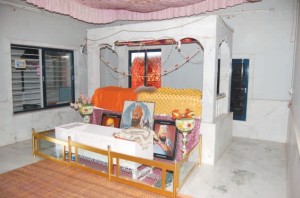 The village is known as Domegaon-Kamalpur, the name ‘Kamalpur’ was given after the name of Kamal Shah, an important executive of emperor Aurangzeb. His Mazaar (grave) is close to the Mandir-Gurdwara complex. Though the population consists of Hindus, Muslims and few Buddhists, yet they have no religious or caste barriers in marriage ceremonies or social dealings. They have days marked for different religious functions, which they all celebrate together.” He pointed out to me that the people, who followed us to the temple that day, included a Hindu, a Muslim and a Buddhist.
The village is known as Domegaon-Kamalpur, the name ‘Kamalpur’ was given after the name of Kamal Shah, an important executive of emperor Aurangzeb. His Mazaar (grave) is close to the Mandir-Gurdwara complex. Though the population consists of Hindus, Muslims and few Buddhists, yet they have no religious or caste barriers in marriage ceremonies or social dealings. They have days marked for different religious functions, which they all celebrate together.” He pointed out to me that the people, who followed us to the temple that day, included a Hindu, a Muslim and a Buddhist.
There were no restrictions in any religious place for anyone. Later I found record of a statement of Shri Vishvanath Korpe and his mother aged 100 in a local Marathi weekly, Hind Mashaal dated 16 June 1994, which carried a detailed version of the events and confirmed the statements by Baba Thorat.
I left the place with genuine respect for a village community united in its veneration for the ancient hand-written volume of Guru Granth Sahib.
